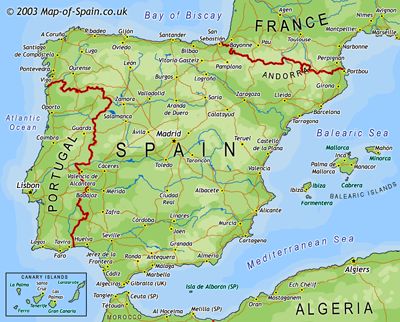 The following is a piece I wrote for Flak Magazine, which, sadly, chose pretty much the same moment to implode. So enjoy this exclusive SJBlog-only review
The following is a piece I wrote for Flak Magazine, which, sadly, chose pretty much the same moment to implode. So enjoy this exclusive SJBlog-only review:
Woody Allen has made his last four movies cinematically exiled from New York. One could argue that his latest,
Vicky Cristina Barcelona, is just another expat romp, but there’s a Spanish vibe that sets it apart from the director’s recent forays to Britain in
Match Point,
Scoop, and
Cassandra’s Dream. It’s been almost 30 years since
Manhattan, but Allen’s jaunt to Spain’s most recognizable seaside city resurrects the kind of urban homage that the director weaved in his classic 1979 film. From the first shots of Antoni Gaudí’s iconic Sagrada Familia temple to the parting shots of Javier Bardem’s chiseled visage, it’s clear that Allen and Barcelona formed an unlikely but successful partnership. Allen doesn’t simply set this movie in Spain but rather – as the title implies – casts Barcelona as one of the protagonists. And it upstages Scarlett Johansson.
Vicky and Cristina, two American friends with nothing better to do than kill July and August in Spain, travel to Barcelona with, as the film’s narrator intones, competing notions of love that will ultimately land them in Bardem’s grasp. Vicky (Rebecca Hall) is engaged to be married and doing research for her master’s degree in “Catalan identity,” although she speaks neither Catalan nor Spanish, putting her at a real disadvantage for that lucrative future consulting job, or whatever it is you do with a degree in Catalan identity. Cristina (Scarlett Johansson) tends more toward free love and is riding the wave of an unsuccessful 12 minute art film to a career as a doe-eyed muse. Upon first meeting the tortured artist Juan Antonio (Bardem), he offers to fly them to Oviedo for a three-way. And we’re off!
The film putters along through food poisonings and Spanish guitar recitals while Juan Antonio works his Spanish seductive magic on Vicky and Cristina, until the real object of his volatile desire appears in the form of María Elena (Penélope Cruz), his similarly-tortured artist ex-wife. Bardem and Cruz, who first put their acting chops on display together in the director Bigas Luna’s sex romp parody of Spanish stereotypes ranging from naked bullfighting to ham-centrism in the 1992 film
Jamón, Jamón, deftly proceed to wrest control of the film away from Allen’s stilted theatrical dialogue toward a chemistry that benches Scarlett Johansson almost entirely. Bardem and Cruz alternate between Spanish and English as they trade violence for desire in vertigo-inducing scenes that add a genuineness of emotion lacking in Vicky and Cristina’s navel-gazing. Allen himself admits that he didn’t know what Bardem and Cruz were saying to each other in Spanish until he transcribed the subtitles: “It wasn’t exactly what I wrote, but it wasn’t bad.”
While
Vicky Cristina Barcelona sticks to much of Allen’s patented formula – the love triangles, the self-doubt, Allen’s own neurosis recast in different characters (here landing in Vicky and her insufferable whining) – the points of departure from his cinematic playbook constitute the film’s livelier moments. Removing his characters from their American comfort zone allows for a scrappier movie, with more surprises than the average Allen film. Although Allen has said that he could have swapped Barcelona for any other European urban center, the combination of the city’s beautifully-filmed architecture and vistas, and two of Spain’s most highly-regarded – and exportable – actors, makes the film a visual homage to the city and, by extension, to Spain. Allen’s barbs at Spain – Juan Antonio keeps harping on María Elena to “Speak English!” in deference to Cristina, who speaks no Spanish, and Vicky’s “Catalan identity” degree needles the sensitivity of a region that fiercely guards its uniqueness from the rest of Spain, regardless of the world’s ambivalence –, the local government’s subsidies of the movie in the face of declining support for Spanish directors, and the traffic hassles incurred when Allen filmed scenes around Barcelona’s most popular attractions piqued the ire of the city’s inhabitants to such a degree that Allen left in a huff. Happily, however, none of his scuff-up with Barcelona is noticeable on screen. On the contrary: as Cristina finds her calling as a photographer and moves beyond capturing images of Barcelona’s tourist sites to snapping photos of everyday life in the city, Allen’s strength in distilling more than just a brochure version of Barcelona and Spain onscreen is clear.
The love quadrangle of Vicky, Cristina, Juan Antonio and María Elena hits moments of deep yet cynical reflection, steamy darkroom hook-ups, and jaunty strolls through city streets magically washed of tourists as each side of the square decides what it is they want out of everyone else. For a moment, it seems as if this bohemian arrangement will sustain itself, but, then again, maybe not. In the end, Vicky and Cristina leave Barcelona with not much more insight about love than they had when they arrived (and not even a basic vocabulary of swear words, which is mystifying after two months among Spaniards), but no matter: the audience is treated to an even better transformation. In a film that is equal parts classic Woody Allen and Global Woody for the 21st century, who cares if Allen understands the dialogue or not? Here’s hoping he continues to shake up the formula and discover new Manhattans more often.
Labels: Movies, Spain








































